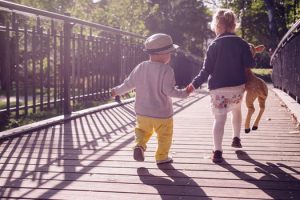

Kids’ feet grow fast: an infant’s foot will reach almost half its eventual adult length by the end of their first year. Toddlers’ feet grow about one shoe size every three to four months, and their feet will double from their birth size by age 4. Babies are born with their feet wide at the toes, which spread out like a fan. As we grow and begin to wear modern (and perhaps more fashionable) footwear, our foot structure is often altered by shoes which isn’t necessarily healthy for foot development.
For little ones learning to walk, allowing their feet to develop naturally is important. A “bad” shoe can hinder their learning process, while an ideal one can keep them comfortable and even assist them as they develop their skills. Here are five tips for choosing the right shoe for your new walker:
Pick the right size: Too tight or too small shoes constrict and restrict your child’s movement. Shoes that are too big and floppy can cause falling and frustration. Trace your little one’s socked foot every four months to use as a size chart when shopping for new shoes. If you can, however, it’s best to have them try shoes on – they likely have two different-sized feet. Choose a shoe that fits the larger foot correctly, and be sure they are in sock (or tights) feet when trying them on.
Wiggle room: Young children should be in shoes that have plenty of room in which to wiggle their toes and ample room for their feet to grow. An ideal fit for a child’s shoe should be a wider toe versus a narrowed toe, and should more closely resemble the natural human shape when barefoot.
Go barefoot: Babies have nice wide feet – the toes literally fan out – and their arch is rounded. The foot muscles and bones will develop to match each child’s appropriate age and growth milestone, but it is important that their feet are allowed to develop at their own pace. When your little one is learning to walk, they need to feel the ground to gain balance and use depth perception.
Soft soles: Barefoot is best, but the optimal shoe for learning to walk is a soft- soled shoe, such as moccasins or those made by brands like Robeez, See Kai Run, Livie & Luca, Bubox and Soft Stars. Make sure the sole is flat. Some brands, although cute versions of miniature Olympic athletic shoes, are not ideal for your baby to learn to walk in. They are fine for occasional dress-up wear or to capture that family photo, but can be unsafe and frustrating for children to wear while developing their walking legs.
Comfort and function: Children’s shoes should not need to be “broken in;” they should be comfortable from the start. Natural fabrics are often more flexible and comfortable. Children also tend to have sweaty feet; fabrics like leather and canvas are breathable and durable.
One thought on “Healthy feet & toes: choosing shoes for new walkers”
Comments are closed.